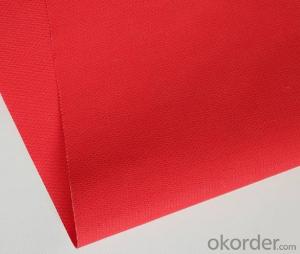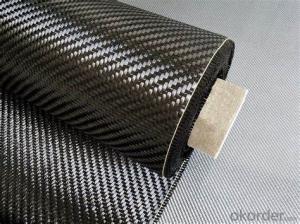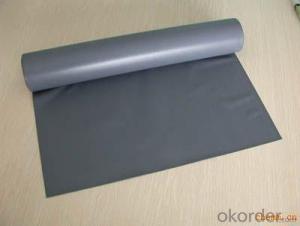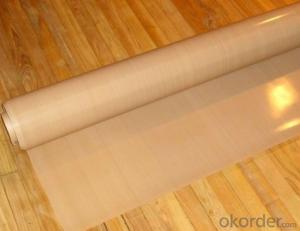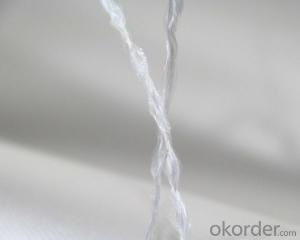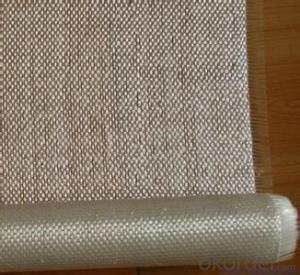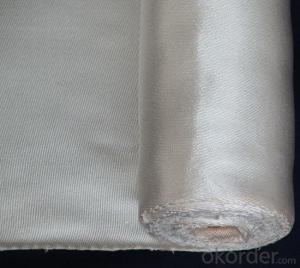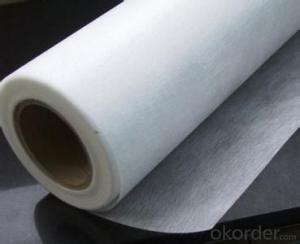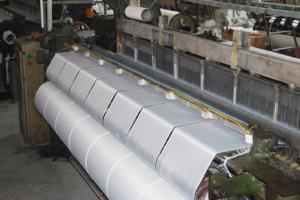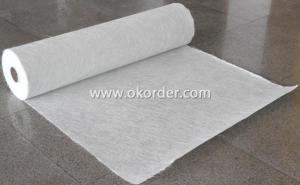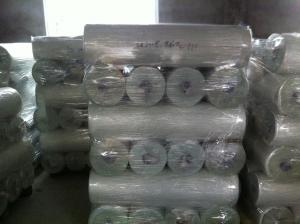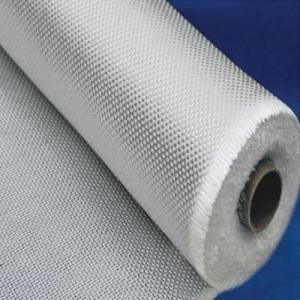Fiberglass Fabrics - High Temperature Resistant Acrylic Coated Fiberglass Fabric
- Loading Port:
- Ningbo
- Payment Terms:
- TT OR LC
- Min Order Qty:
- 500 m²
- Supply Capability:
- 300000 m²/month
OKorder Service Pledge
OKorder Financial Service
You Might Also Like
Description: The acrylic coated glass fiber cloth overcomes the shortcomings of glass fiber cloth that is not wear-resistant, itchy, and easy to loose yarn after cutting, so that our fire resistant cloth als and performs processing on the glass fiber cloth. It has better wear resistance, easy processing and aesthetic properties. Acrylic coated cloth can withstand higher operating temperatures. Acrylic texture stabilizer with high quality is flame-retardant, low-smoke, temperature resistance of 550 C, feels moderately soft and hard, and has a reasonable cost. Therefore, this coated fabric can be made into welding blanket, insulation covers, fire blanket, fire curtain, fireproof cloth for fire protection. In high temperature operations such as heat preservation, welding protection, fire protection, steel, shipbuilding industry, etc.
Features: Fireproof, Abrasion Resistance, Corrosion Resistance
Application: Fire Blanket, Welding Blanket, Insulation Blanket, Fire Curtain, Welding Curtain, Smoke Curtain, Fire Doors
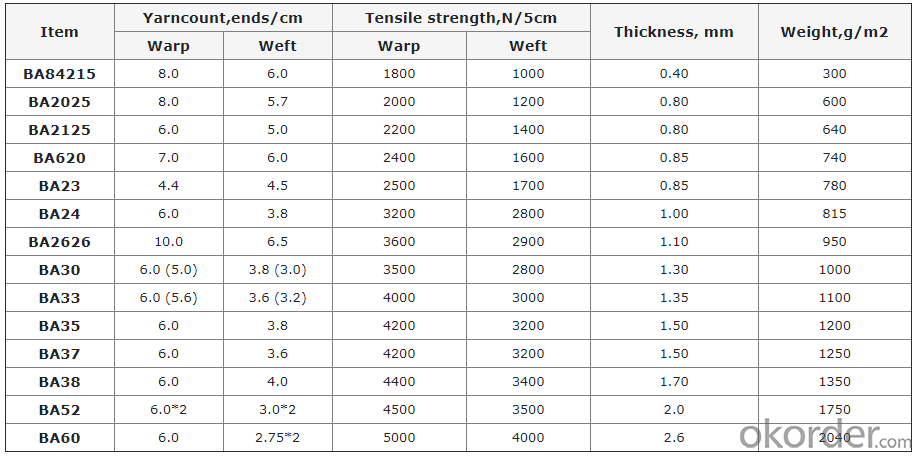
UNIT: square meter
MOQ: 500 square meters
Weight: 140gsm-3000gsm or customized
Width: 1m-2m or customized
Yarn Type: E-glass
Standing temperature: up to 550℃
Product name: Acrylic coated fiberglass fabric
Coating/Finish/Surface Treatment: Acrylic coated
Roll length: 50 meter or customized
Color: Yellow,Black,White,Brown,Blue,Orange,Gray,Salmon,Red or customized
Weave Type: plain woven
Alkali content: alkali free
Processing service: cutting
Material: fiberglass fabric, Acrylic
Thickness: 0.1mm to 3mm or customized
Size: can be customized
Supply ability: 300000 meters per month
Packaging: Acrylic coated fiberglass fabric rolls covered with film packed in cartons loaded on pallets or according to customers' requirements.
Lead time: 7-30 days
- Q: Are fiberglass fabrics suitable for use in the agricultural industry?
- Yes, fiberglass fabrics are suitable for use in the agricultural industry. Fiberglass fabrics offer several properties that make them ideal for agricultural applications. Firstly, fiberglass is known for its high strength and durability, making it capable of withstanding the harsh conditions often found in agricultural settings. This means that fiberglass fabrics can be used for various purposes such as covering greenhouses, protecting crops from pests and extreme weather conditions, and reinforcing agricultural equipment. Additionally, fiberglass fabrics are resistant to chemicals and UV radiation, which is essential in the agricultural industry as it often involves the use of fertilizers, pesticides, and exposure to sunlight. The resistance to chemicals ensures that the fiberglass fabrics will not degrade or be negatively affected by these substances. Furthermore, the UV resistance prevents the fabric from deteriorating or becoming brittle when exposed to sunlight for extended periods. Another advantage of fiberglass fabrics in the agricultural industry is their fire resistance. This property is crucial as it helps to prevent the spread of fire in case of accidents or incidents involving flammable materials commonly found in agricultural settings. Moreover, fiberglass fabrics are lightweight and easy to handle, making them convenient for various applications in the agricultural industry. They can be easily cut and tailored to fit specific requirements, allowing for customization based on the needs of farmers and agricultural workers. Overall, the strength, durability, chemical resistance, UV resistance, fire resistance, and ease of handling make fiberglass fabrics highly suitable for use in the agricultural industry. They provide a reliable and versatile solution for various applications, contributing to the efficiency and productivity of agricultural operations.
- Q: Can fiberglass fabric be used in wet or humid environments?
- Indeed, wet or humid environments can accommodate the use of fiberglass fabric. Regarded as an incredibly adaptable substance, fiberglass is renowned for its ability to withstand moisture and humidity. It possesses the remarkable quality of not absorbing water, rendering it impervious to the detrimental effects of mold or mildew. Consequently, it becomes an exceptional choice for various purposes such as constructing boats, manufacturing outdoor furniture, and providing insulation in regions prone to excessive moisture. Moreover, fiberglass fabric exhibits resistance to corrosion, thus rendering it suitable for deployment in marine settings or areas characterized by high salt content. On the whole, fiberglass fabric represents a robust and dependable alternative for utilization in wet or humid environments.
- Q: Do fiberglass fabrics have any electrical conductivity properties?
- No, fiberglass fabrics do not have any electrical conductivity properties.
- Q: How does fiberglass fabric perform in static dissipation?
- Fiberglass fabric does not perform well in static dissipation. It is a non-conductive material that tends to accumulate static electricity rather than dissipating it.
- Q: What are the different thickness options for fiberglass fabric rolls?
- The thickness options for fiberglass fabric rolls can vary, but commonly range from 0.5 oz to 6 oz per square yard.
- Q: How is fiberglass fabric used in the production of composite materials?
- Fiberglass fabric is used in the production of composite materials as a reinforcement material. It is typically combined with resin to create a strong and lightweight composite structure. The fabric provides strength and durability to the composite material, making it suitable for various applications such as aerospace, automotive, and construction industries.
- Q: Are there any health risks associated with exposure to fiberglass fabrics?
- Yes, there can be health risks associated with exposure to fiberglass fabrics. Fiberglass is made of tiny fibers that are sharp and can easily become airborne when the fabric is disturbed or damaged. When these fibers are inhaled or come into contact with the skin, they can cause irritation, itching, and redness. Prolonged exposure to fiberglass fibers can also lead to more serious health issues such as respiratory problems, lung damage, and even cancer. In addition to direct contact, fiberglass fabrics can also release small particles into the air, making them a potential respiratory hazard. Breathing in these particles can cause coughing, wheezing, and shortness of breath. People with pre-existing respiratory conditions such as asthma or chronic obstructive pulmonary disease (COPD) may be particularly susceptible to these effects. To minimize the health risks associated with fiberglass fabrics, it is important to take precautions when working with or around them. This includes wearing appropriate personal protective equipment such as gloves, goggles, and a respiratory mask to prevent direct contact and inhalation of the fibers. It is also important to handle fiberglass fabrics carefully to avoid damaging them and releasing fibers into the air. If you suspect that you have been exposed to fiberglass fibers and are experiencing any symptoms such as skin irritation or respiratory issues, it is advisable to seek medical attention. A healthcare professional can assess your condition and provide appropriate treatment if necessary.
- Q: How does fiberglass fabric perform in moisture resistance?
- Fiberglass fabric generally performs well in moisture resistance. It is naturally water-resistant and does not absorb moisture easily. This makes it suitable for various applications where exposure to moisture is common, such as boat and yacht construction, outdoor furniture, and even in the automotive industry. Additionally, fiberglass fabric can withstand high humidity levels without compromising its structural integrity or performance. However, it is important to note that while fiberglass fabric is resistant to moisture, it is not completely waterproof. Prolonged exposure to water or submersion may eventually lead to some water absorption. It is always recommended to consult the specific product specifications and manufacturer guidelines to determine the level of moisture resistance for a particular fiberglass fabric.
- Q: How is fiberglass fabric used in the production of insulation boards?
- Fiberglass fabric is used in the production of insulation boards as it provides excellent thermal insulation properties. It is typically layered or woven into the board structure to enhance its insulating capabilities, helping to trap air and reduce heat transfer. Additionally, fiberglass fabric improves the strength and durability of the insulation board, ensuring it can withstand handling and installation without losing its insulating performance.
- Q: What are the different fiberglass fabric weaves for chemical resistance?
- There are several different fiberglass fabric weaves that are known for their chemical resistance. Some commonly used weaves include plain weave, twill weave, satin weave, leno weave, and basket weave. Each of these weaves offers a unique structure and pattern, which contributes to the fabric's resistance to various chemicals. It's important to select the appropriate weave based on the specific chemicals and conditions the fabric will be exposed to.
Send your message to us
Fiberglass Fabrics - High Temperature Resistant Acrylic Coated Fiberglass Fabric
- Loading Port:
- Ningbo
- Payment Terms:
- TT OR LC
- Min Order Qty:
- 500 m²
- Supply Capability:
- 300000 m²/month
OKorder Service Pledge
OKorder Financial Service
Similar products
Hot products
Hot Searches
Related keywords
